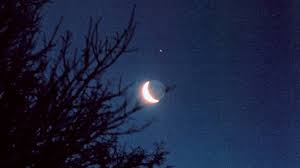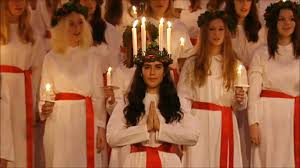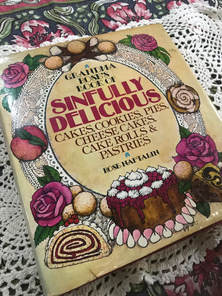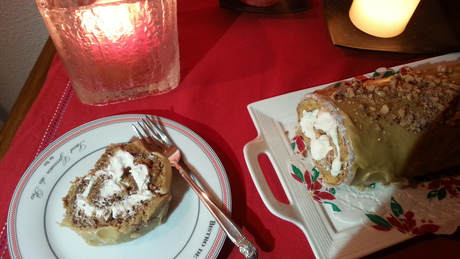One of the oldest and most familiar universal symbols is the circle. Circles represent completion and eternity, and circles abound in Christmas festivities. People hang wreaths on their doors as a sign of hospitality, and one of the most popular Christmas tree ornaments is the shining glass ball, either decorated or plain, reflecting the warm lights on the tree.
The name Lucia means “light” in Latin, and when the most northern European countries were Christianized, around the year 1,000, St. Lucia’s story as the bringer of light was superimposed on the ancient Winter Solstice festivities, offering hope where darkness and cold prevail for months each year. In Scandinavian countries, especially Sweden, St. Lucia’s Day begins the Christmas festivities. As part of the St. Lucia celebration, girls dressed in white robes with an evergreen wreath circled with lighted candles on their heads, present saffron buns, cookies and other festive treats to their parents and family members as a remembrance of St Lucia, the generous bringer of light. St. Lucia pageants also take place in schools, churches and other community settings.
Eventually, as the communal custom of cutting a large log and burning it outside became rare, the Yule Log evolved as the subject of visual art, Christmas cards and even pastry. In France, a cake called Buche de Noel, (Yule Log in French) was developed in the Nineteenth Century to resemble an actual Yule Log made of wood. This visually captivating pastry is made from a sponge cake baked as a jelly roll, filled with pastry cream or icing, rolled up and decorated with more icing, usually chocolate to resemble a log. When it is sliced, the spiral interior continues the ancient symbol of the eternal circle.
I have made many Yule Logs over the years, as they truly capture the warmth and joy of Christmas. And a Yule Log is the perfect dessert for any holiday gathering. Our Christmas Tea in the December calendar section of this website features a Yule Log which I developed based on a recipe I found in a charming little cookbook entitled Grandma Rose’s Book of Sinfully Delicious Cakes, Cookies, Pies, Cheese Cakes, Cake Rolls and Pastries, published in 1975 by Rose Naftalin. Every recipe in this little book, which contains no photographs or illustrations, is a gem. I adapted Rose’s Praline Nut Roll recipe to create a caramel and almond Yule Log using pulverized Heath Bars sprinkled over the top to resemble the dusty appearance of an oak log. It is my pleasure to share this recipe with you this Christmas. Feel free to allow your own imagination to soar and add any variations or decorations that capture your fancy. After all, Christmas is a time for ancient symbols and traditions, but it is also a holiday that celebrates new birth.
Merry Christmas to you and your family.
Caramel Toffee Yule Log
The Bouche de Noel, or Yule Log, is a Christmas tradition in French speaking regions. It is an ingenious sponge cake, filled and rolled up to resemble a log, reminding us of the warmth of the hearth during the cold winters. Yule Logs can be any flavor, with a variety of possible fillings and icing decorations on top. Some of these decorations are very elaborate, including marzipan mushrooms and chocolate icing carefully raked to resemble tree bark. Often the platter on which the Bouche de Noel is served is also decorated with holly or evergreen sprigs.
Our Yule Log is caramel and almond praline flavored and designed to look somewhat like an organic log, minus the extra hours it would require to make marzipan mushrooms, leaves, and perhaps tiny elves. The tan caramel icing will be sprinkled with pulverized Heath Bars, creating the brown look and texture of a log. This is also a delicious creation, and the whole thing can be made in advance, placed on a decorative platter, and frozen until Christmas Tea Party time.
For the almond praline cake roll:
- 5 eggs, separated
- ¾ cup sugar
- 1 cup ground toasted almonds (If starting with whole almonds, you will need more than 1 cup)
- 3 Heath candy bars
- 3 tablespoons flour
- 1 teaspoon baking powder
- 1 teaspoon vanilla
- ¼ teaspoon salt
- ½ teaspoon cream of tartar
- cooking spray for the pan
- powdered sugar for sprinkling
- sprigs of holly, evergreens, or candied cranberries for decoration.
Preheat oven to 350° F
Special equipment: 11 x 16” jellyroll pan, parchment paper, food processor, 2 large mixing bowls, electric mixer, rubber spatula, clean cotton tea towel, flour sifter or sieve, medium sauce pan, kitchen knife
- Pulse the toasted almonds in a food processor until finely ground. (It will require more than 1 cup of whole almonds to produce 1 cup of ground almonds.) Remove the ground almonds and add the Heath bars, broken into pieces, to the food processor. Pulse until finely crushed. Sift together the flour and baking powder. Spray the jellyroll pan with cooking spray and line it with parchment paper. Spray and lightly flour the paper.
- Separate the eggs by placing the yolks in one large mixing bowl and the whites in another large mixing bowl. Beat the yolks with an electric mixer until frothy and gradually add ½ cup sugar. Continue to beat for 4-6 minutes, until the mixture ribbons when the beater is lifted. Stir in the ground almonds, 1/3 cup of crushed Heath bars, flour and baking powder mixture, and vanilla.
- Clean the beaters for the mixer and beat the egg whites until they start to turn white and hold their shape. Add the salt and cream of tartar and beat until soft peaks form. Gradually beat in the remaining ¼ cup of sugar, a little at a time, continuing to beat until stiff.
- Add ¼ of the whites to the yolk mixture, folding them in gently with a rubber spatula. Pour the yolk mixture over the remaining egg whites and gently fold the mixture together until no egg white is visible. Pour the batter into the prepared jellyroll pan, spreading it evenly with the spatula.
- Bake for 20 minutes or until the cake begins to shrink from the sides of the pan. Lay a cotton tea towel on the counter and sprinkle it with powdered sugar. Loosen the edges of the cake and invert it on the tea towel. Let the cake cool slightly, peel off the parchment paper and roll up the cake from the short side in the tea towel. Cool completely with the seam side down.
For the whipped cream filling:
- 1 cup heavy cream
- 2 tablespoons powdered sugar
- 1 teaspoon vanilla
- Clean the beaters for the electric mixer, and clean one of the large mixing bowls. Chill them in the freezer for a few minutes. Beat the heavy cream until it thickens. Beat in the powdered sugar and vanilla. Continue to beat the cream until it holds stiff peaks.
- Unroll the cake and spread the whipped cream evenly over it, leaving a little space on all four sides. Carefully reroll the cake, place it on the platter on which you plan to serve it, and refrigerate it while you are making the icing.
For the caramel icing:
½ cup brown sugar
¼ cup heavy cream
3 tablespoons unsalted butter
7 tablespoons powdered sugar
¼ cup ground Heath candy bars
- In a medium sized saucepan, combine the brown sugar, cream and butter. Bring the mixture to a boil and cook, stirring, over moderate heat for 2 minutes. Let it cool to lukewarm. Beat in the powdered sugar.
- Remove the Yule Log from the refrigerator and quickly spread the icing over the log, making sure to cover the sides and ends. Use a table knife to make long indentations up and down the length of the log to resemble tree bark. Quickly sprinkle the remaining crushed Heath bars over the icing to create the appearance of a natural log. You may wish to add sprigs of holly or evergreen or candied cranberries to decorate your log.






 RSS Feed
RSS Feed